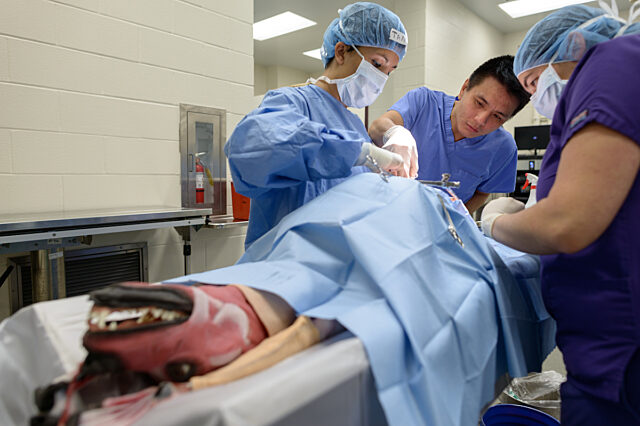UF veterinary students advance surgery skills using synthetic canine cadavers

University of Florida veterinary medical students are implementing some of the most advanced technology in the world by using the first-ever synthetic canine cadavers in a surgery lab.
The canine models, which bleed and even have a pulse, have all of the bones, muscles, relevant organs and vascular components found in actual dogs. Made from a library of more than 100 synthetic materials that mimic actual living tissue in terms of mechanical properties, densities and other properties, the model “is an actual synthetic animal with all of the relevant body systems, with a heart that actually pumps synthetic blood through the core, organs and limbs,” said Christopher Sakezles, president of SynDaver Labs, which makes synthetic human cadavers as training aids in human medicine. “It can be intubated and ventilated.”
The UF College of Veterinary Medicine bought 25 of the true-to-life models last year after talks with SynDaver Labs. Initially, a team including the college’s executive director, John Haven, and UF small animal surgeons J. Brad Case, D.V.M., and Stanley Kim, B.V.Sc., visited the company’s headquarters in Tampa to discuss whether the company could create a canine abdominal model that veterinary medical students could use in surgery courses as an alternative to canine cadavers.
“During the visit, we showed them our current human technology and I suggested building the full dog, because, why not?” said Sakezles.
Further discussions then ensued with the UF surgeons to tweak the model’s design.
“We gave them a list of specific features we wanted to see in the model,” said Kim, an assistant professor of small animal surgery at UF. “They then built a prototype and brought it up for us to test. We tested and provided feedback on three or four iterations of the model before the final product was created.”
The students who participated in the first lab on Nov. 29 were seniors enrolled in an advanced surgery course. Two labs were held in different time slots on that day with students stationed in teams at different work tables. The class was given a series of abdominal surgical procedures to perform — a splenectomy and a liver biopsy were on the list but other types of procedures will be covered in the future — with audiovisual monitors installed on walls above each station as teaching aids.
Chris Alling, a senior UF veterinary medical student who participated in the lab, said the models were helpful from a student’s perspective because all of the typical pressures of surgery, including blood loss, anesthesia maintenance and asepsis, are removed, or at least mitigated.
“Of course, we still do our best to maintain sterile technique and limit hemorrhage, but when errors are made, we don’t experience the same level of anxiety as if we had endangered a living, breathing patient,” Alling said. “This allows us to focus more fully on the surgical techniques themselves, which ultimately builds confidence for when we will be eventually faced with real cases.”
The models are compatible with all known surgical instruments and imaging techniques.
“I thought the lab went spectacularly,” said Case, who assisted in teaching the class. “I think it was great that the seniors got the first shot and were able to do the more advanced procedures. That said, I think the sophomores this spring will love being able to perform their first-ever mock spay procedure in a SynDaver canine versus through the historic use of cadavers. I am really looking forward to that.”
Kim added that he felt “very fortunate” to be a part of the team that delivered this experience to the students.
“It may turn out to be one of my biggest contributions to veterinary medicine,” he said. “Simulation is the way of the future for surgical training in both the human and veterinary fields, and in helping to develop this model, we at UF are leading the way in simulation veterinary surgery.”
About the author
